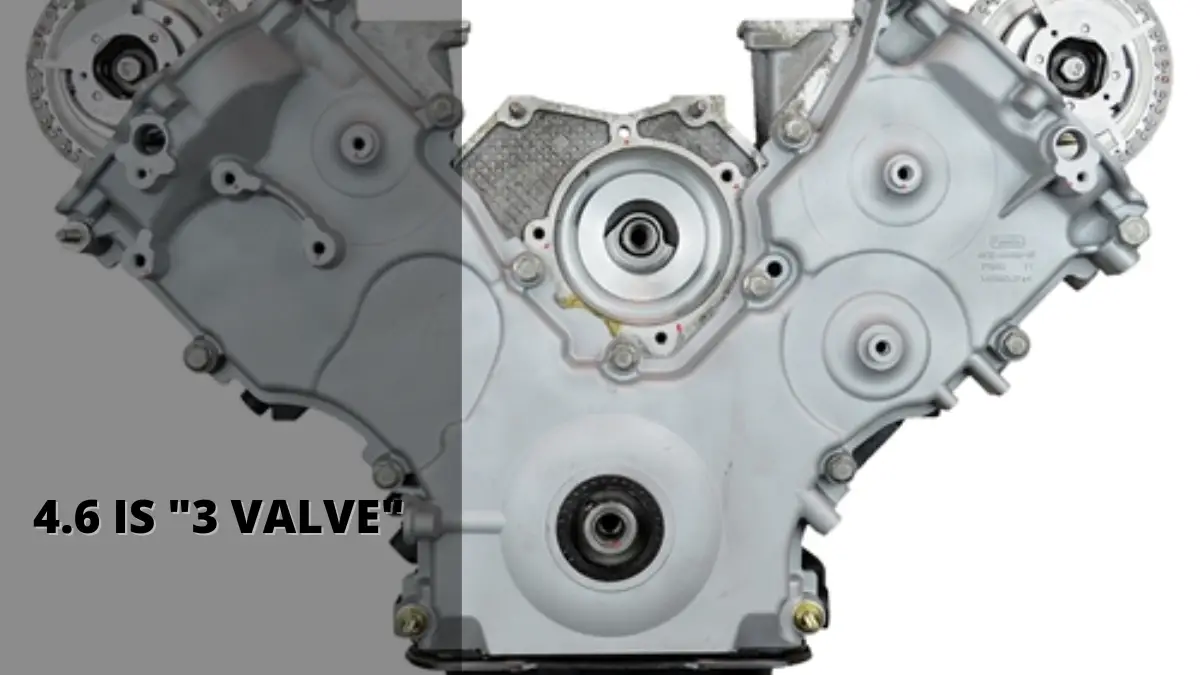When people say the 4.6 is “3 valve”, they are referring to the Ford 4.6-liter V8 engine with a three-valve per cylinder head design.
The number of valves in an engine refers to the number of openings in the cylinder head that allow air and fuel to enter and exhaust gases to exit the combustion chamber.
Generally, more valves per cylinder can improve airflow and increase power. The three-valve design of the Ford 4.6-liter V8 engine features two intake valves and one large exhaust valve per cylinder, which is designed to improve velocity and volume.
The three-valve design also saw substantial upgrades in power compared to the two-valve design, especially in the case of the Mustang.
History of the Ford 4.6 3-Valve Engine
To fully understand the 4.6 3-valve engine, we must first dive into the history of the Ford Modular engine family. This family of engines was introduced in 1991 as a replacement for the aging Ford Windsor small-block V8 engines.
The Modular engine family consists of a range of V8, V10, and V12 engines, with various configurations and displacements.
Ford first introduced the 4.6 3-valve engine in the 2005 Mustang GT, and it was also used in other Ford and Lincoln vehicles. This engine was designed to improve upon the previous 4.6 2-valve engines by increasing horsepower, torque, and efficiency.
It is worth noting that the 4.6 3-valve is a member of the 4.6L family, which also includes 2-valve and 4-valve variants.
Key Features of the 4.6 3-Valve Engine
The most notable feature of the 4.6 3-valve engine is, of course, the three valves per cylinder. This setup includes two intake valves and one exhaust valve, which allows for increased airflow and better combustion efficiency.
This design results in improved horsepower, torque, and fuel efficiency compared to 2-valve engines.
Variable Camshaft Timing
Another essential feature of the 4.6 3-valve engine is the variable camshaft timing (VCT) system. This technology allows the engine to optimize valve timing based on driving conditions, leading to improved power, fuel efficiency, and reduced emissions.
VCT also enables a broader torque curve, which translates to more usable power throughout the RPM range.
Performance Upgrades and Aftermarket Support
The 4.6 3-valve engine is well-supported by the aftermarket, with numerous performance upgrades available. Common modifications include cold air intakes, exhaust systems, and performance tunes, which can all help unlock additional horsepower and torque.
Applications of the 4.6 3-Valve Engine
The 4.6 3-valve engine was used in various Ford and Lincoln vehicles throughout its production run. Some notable applications include:
- 2005-2010 Ford Mustang GT
- 2006-2010 Ford Explorer
- 2006-2010 Mercury Mountaineer
- 2005-2008 Lincoln Mark LT
Conclusion
The 4.6 3-valve engine is an intriguing and capable member of the Ford Modular engine family. Its unique valve configuration and advanced technologies contribute to impressive power and efficiency gains over its 2-valve counterparts.
While it may not be the most powerful engine in the family, the 4.6 3-valve still holds a special place in the hearts of automotive enthusiasts.
This engine has proved its versatility in a variety of applications, from sports cars like the Mustang GT to SUVs and trucks. Its potential for performance upgrades and strong aftermarket support has also made it a popular choice among those looking to extract even more power from their vehicles.
FAQs
- What is the difference between a 2-valve and 3-valve engine? A 2-valve engine has one intake and one exhaust valve per cylinder, while a 3-valve engine has two intake valves and one exhaust valve per cylinder. The 3-valve configuration typically allows for better airflow and improved combustion efficiency, leading to increased power and fuel efficiency.
- How does variable camshaft timing (VCT) work? Variable camshaft timing (VCT) is a technology that adjusts the timing of the intake and exhaust valves based on driving conditions. This allows the engine to optimize valve timing for improved power, fuel efficiency, and reduced emissions.
- What are some common performance upgrades for the 4.6 3-valve engine? Common performance upgrades for the 4.6 3-valve engine include cold air intakes, exhaust systems, and performance tunes. More advanced modifications, such as superchargers and turbochargers, can also be used to significantly increase power output.
- Are there any known issues with the 4.6 3-valve engine? While the 4.6 3-valve engine is generally considered reliable, some common issues include problems with the variable camshaft timing system and spark plug removal difficulties. Regular maintenance and addressing any issues promptly can help keep the engine running smoothly.
- Can the 4.6 3-valve engine be swapped into other vehicles? Yes, the 4.6 3-valve engine can be swapped into other vehicles, but it may require significant modifications and custom work to fit correctly. It’s crucial to consult with a knowledgeable mechanic or perform extensive research before attempting an engine swap.


